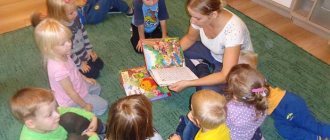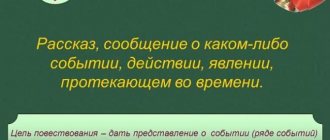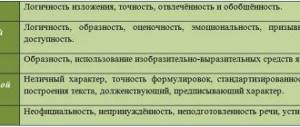Lesson summary of the Russian language “Word ending”
TOPIC: End of a word.
(With presentation)
Goal:
Updating knowledge and recording difficulties in activities.
Please read the sentences on the slide and find the form of the same word.
The birch is called the symbol of Russia.
My Rus', I love your birches!
The birch tree is sung in poetry.
A fungus was found under a birch tree. Songs were written about the birch tree. The buds have blossomed on the birch trees.
Write down these words and highlight the root in them.
Setting a learning task
See if all parts of the word are highlighted?
Can we name this part of the word? Why? So our goal is to find out.
Where is the part of the word that we did not highlight. What would you call it?
That's right, this part of the word is called the ending and it stands out like this
Highlight the ending in your words.
Please formulate the topic of the lesson.
Part of the word is the ending.
Now let's set specific goals for ourselves.
What should we learn from this lesson?
- What is ending?
- What is the ending for?
- How to find the ending?
Building a project to get out of a problem
What is the ending? Your guess.
That's right, it's part of the word. What part of the word is this?
Please look at your words. Say the endings in the same word form. What do you see? Guess what part of the word this is? That's right, it's a variable part of the word.
Let's repeat once again what parts of the word we now know.
What is the root and what is the ending?
We completed the first task. Now we need to find out what the ending is for.
Please look at the slide. Is everything the same in writing these sentences? What do we need to change? For what? Change it. What changes? So, what is the ending for?
ENDING is a variable part of a word, used to connect words in a sentence
Now read the text you got. What do we know about this holiday?
On November 4, Russia celebrates National Unity Day.
For the first time in Russia, this new national holiday was celebrated on November 4, 2005.
National Unity Day was established in memory of the events of 1612, when the people's militia was under
The leadership of Kuzma Minin and Dmitry Pozharsky liberated Moscow from Polish invaders.
Now read the pairs of words on the next slide, analyze, draw a conclusion and formulate a way to highlight the ending.
To highlight the ending, you need to change the word by numbers. Which part of the word changes at the end and is the ending. Please note that this verification method is suitable for any part of speech.
Let's check with the textbook whether we made the right conclusions.
Primary consolidation
Now let’s review everything we learned about endings in today’s lesson. (Cards)
(Bullfinch) live in forests with dense undergrowth. In summer, the bullfinch lives in both dense forests and open woodlands. The bullfinch feeds on seeds, buds and berries. A very apt name given (bullfinch). In winter, flocks (of bullfinch) are very clearly visible against a snow-white background.
What should we do to restore the connection between words in a sentence? Let's highlight the ending, what should we do for this?
Independent work with self-test according to the standard
Read the text on the slide, write down the form of one and the same word, highlight the ending.
1. Poplar fluff swirled in the air. It's easy to breathe sea air. Without air, all life on Earth will die. (After execution there is a check against the standard.)
2.Write the name of the trees from the text and highlight the ending.
Each tree has its own appearance. Pine is slender. Curly birch. Spreading willow. Trembling aspen. Mighty oak.
Why can't we highlight the ending in the word "oak"? Let's try to change it by numbers. What happens? Draw a conclusion.
That's right, guys, there are words in which the ending is not indicated by a sound, but appears when the form of the word changes. This ending is called zero.
3.Please make up a sentence using the words:
sparkling, earth, lies, on, snow
Write the sentence in your notebook. Highlight the endings in the words. Test yourself against the standard.
Reflection on activity (lesson summary)
Let's summarize today's lesson and answer the following questions:
- What is ending?
- What is the ending for?
- How to find the ending?
- What is null ending?
D.Z.
Write it down, changing the words in brackets according to their meaning. Highlight the ending in them.
(Bullfinch) live in forests with dense undergrowth. In summer, the bullfinch lives in both dense forests and open woodlands. The bullfinch feeds on seeds, buds and berries. A very apt name given (bullfinch). In winter, flocks (of bullfinch) are very clearly visible against a snow-white background.
Write it down, changing the words in brackets according to their meaning. Highlight the ending in them.
(Bullfinch) live in forests with dense undergrowth. In summer, the bullfinch lives in both dense forests and open woodlands. The bullfinch feeds on seeds, buds and berries. A very apt name given (bullfinch). In winter, flocks (of bullfinch) are very clearly visible against a snow-white background.
Write it down, changing the words in brackets according to their meaning. Highlight the ending in them.
(Bullfinch) live in forests with dense undergrowth. In summer, the bullfinch lives in both dense forests and open woodlands. The bullfinch feeds on seeds, buds and berries. A very apt name given (bullfinch). In winter, flocks (of bullfinch) are very clearly visible against a snow-white background.
Write it down, changing the words in brackets according to their meaning. Highlight the ending in them.
(Bullfinch) live in forests with dense undergrowth. In summer, the bullfinch lives in both dense forests and open woodlands. The bullfinch feeds on seeds, buds and berries. A very apt name given (bullfinch). In winter, flocks (of bullfinch) are very clearly visible against a snow-white background.
Write it down, changing the words in brackets according to their meaning. Highlight the ending in them.
(Bullfinch) live in forests with dense undergrowth. In summer, the bullfinch lives in both dense forests and open woodlands. The bullfinch feeds on seeds, buds and berries. A very apt name given (bullfinch). In winter, flocks (of bullfinch) are very clearly visible against a snow-white background.
Write it down, changing the words in brackets according to their meaning. Highlight the ending in them.
(Bullfinch) live in forests with dense undergrowth. In summer, the bullfinch lives in both dense forests and open woodlands. The bullfinch feeds on seeds, buds and berries. A very apt name given (bullfinch). In winter, flocks (of bullfinch) are very clearly visible against a snow-white background.
Write it down, changing the words in brackets according to their meaning. Highlight the ending in them.
(Bullfinch) live in forests with dense undergrowth. In summer, the bullfinch lives in both dense forests and open woodlands. The bullfinch feeds on seeds, buds and berries. A very apt name given (bullfinch). In winter, flocks (of bullfinch) are very clearly visible against a snow-white background.



